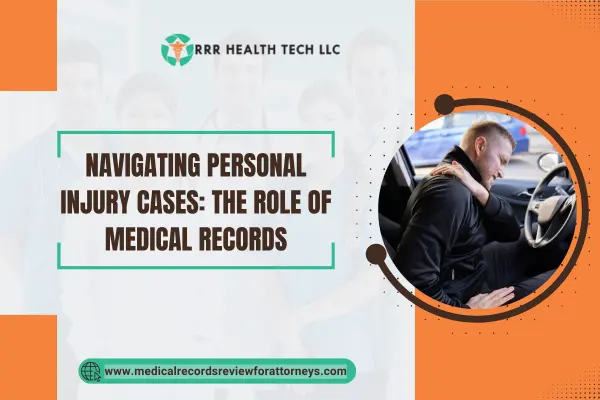
Introduction
Evidence is crucial in personal injury cases. One of the most vital ones is medical records review which involves exhaustive scrutiny of documents on injuries, treatments, and patient reactions. These reports are important to identify the liable party and establish how the incident occurred, which determines the outcome of the claim.
Understanding the Significance of Medical Records in Personal Injury Cases
Medical records are very important when it comes to personal injury cases as they provide solid proof required to establish liability and causation. Such files link accidents with injuries sustained thus essential in proving fault.
Accurate medical documentation also plays a crucial role in assessing the extent of injuries. This includes:
- Presenting recovery durations
- Emphasizing possible future health complications
- Stating out figures for rightful compensation
The level at which these records are detailed, and accurate may significantly impact so much on both case strength as well as potential recovery.
The Essential Steps of the Medical Records Review Process
Types of Medical Records Examined
Comprehensively understanding a personal injury case calls for examining various healthcare information sources during medical chart review. Key types commonly examined include:
- ER Records: They show how immediate effects were felt after an accident or any other form of harm caused before full recovery started taking place.
- Discharge Summaries: Provide an overall view of what happened while someone was admitted there such as instructions given on how to come back home, or follow-ups made after a certain period.
- Special Reports: A report from an expert who has treated or evaluated you gives more details about different aspects of your condition.
Some sorts play significant roles in certain types of impairment claims:
- Neurologist Reports: Such papers explain cognitive difficulties together with nervous system impairments associated with head traumas.
- Orthopedic Surgeon Reports: They state surgeries done to rectify bone fractures, joint injuries, or musculoskeletal issues.
Taken together, these documents help in establishing the extent of injuries, treatment received and long-term medical needs hence providing a strong ground for personal injury claims.
Role of Independent Medical Reviews
The use of independent medical reviews by disinterested health professionals significantly increases the confidence in which personal injury cases are presented. Expertise allows them to detect any inconsistencies or gaps within the course of treatment that they may come across during the review process. This usually involves:
- Medical Chart Review: Evaluating records from ERs as well as discharge summaries plus consult reports
- Healthcare Information Analysis: Looking at neurologist reports or orthopedic surgeon reports for different kinds of damages.
- Defense Medical Examination: Making thorough assessments to confirm findings.
It is only through such meticulous scrutiny that overall analysis can be done thereby revealing biases that could be otherwise overlooked.
Overcoming Challenges and Ensuring Accuracy in Medical Records Review for Personal Injury Claims
Medical terminology complexities and large volumes of data make it difficult to review medical records for personal injury cases. Here are some ways to get around this problem:
1. Employ specialized software tools
Using software platforms designed specifically for reviewing medical records can be very helpful. These instruments will assist in understanding complex medical terms as well as organizing massive amounts of data effectively.
2. Get help from medical professionals
If you are familiar with the uncommon terms and procedures in the medical field, taking the advice of healthcare experts will help to simplify its complexities. This way, one can accurately interpret medical information and get a precise interpretation of minor details.
3. Pay attention to the patient history section
The patient history segment usually has very important information that may be significant in the case. It could cover details about preexisting conditions, past treatments as well as progress made in recovery.
There are several strategies that you can use to achieve this while conducting a review:
- Double-check all entries: Review each item entered the system carefully for any inconsistencies or errors before submission.
- Cross-reference information: Ascertain data authenticity by comparing it from more than one source or document.
- Maintain consistency: Standardized guidelines should be used when documenting results so that they remain identical amongst reviewers involved in different cases.
Conclusion
When it comes to personal injury cases, it is important to review medical records detail by detail. This is because:
- It helps determine who is at fault (liability).
- It serves as concrete evidence of the injuries sustained.
Therefore, by giving a lot of attention to reviewing medical records comprehensively, you can construct a strong case that supports your claim.
Discover the secret to maximizing your personal injury settlement
FAQs (Frequently Asked Questions)
What are personal injury cases and how do medical records impact them?
Personal injury cases are legal disputes arising from an individual’s injury because of the negligent or wrongful actions of another person. In such litigation, medical files play a vital role since they serve as crucial elements for proving both liability and causation and for showing how severe the victim’s injuries were.
What types of medical records are typically reviewed in personal injury cases?
Commonly examined medical records include emergency room notes, discharge summaries, and specialized consultation reports such as those coming from neurologists and orthopedic surgeons. Each document type provides unique information regarding various aspects of an injury claim.
Why is a thorough review of medical records important in personal injury claims?
Strengthening personal injury claims requires carrying out a comprehensive analysis as it ensures that all relevant information has been considered. This comprehensive analysis supports the victim’s case and enhances their chances of achieving justice through appropriate compensation.


